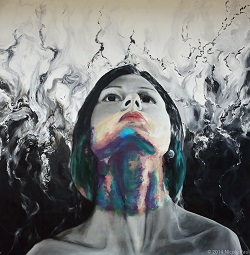Promoting perspectives: Canada's emerging Aboriginal artists
Supporting Historica Canada's annual Aboriginal Arts & Stories competition since 2005
When the call about the award came, Nicole Paul’s ears failed her.
“Could you repeat that, please?” she asked, astonished.
Paul’s painting, Keeper of the Voice, had been awarded top prize in the senior art category as part of Historica Canada’s prestigious 2014 Aboriginal Arts & Stories competition. The annual contest, which has operated with financial support from Enbridge since 2005, encourages Aboriginal youth to explore and document their heritage through stories and visual arts.

Nicole Paul's painting Keeper of the Voice, a mixed-medium self-portrait, was inspired by her interviews with residential school survivors from across Canada, and by her father's experience in the system.
“When I was first told I had placed first, I was shocked . . . I think I cried a little bit,” recalls Paul. “I was ecstatic my message was about to be spread to so many people.”
Paul’s message, delivered via a massive eight-by-eight-foot, mixed-medium self-portrait, was inspired by her interviews with residential school survivors from across Canada, and by her father’s experience in the system.
“One thing they all stressed was the impact that losing their language had on them. After hearing their tragedies, it inspired me to respond,” says Paul, a fine arts student at the University of Saskatchewan.
Promoting awareness is a key goal of Historica Canada’s Aboriginal Arts & Stories competition – awareness of Aboriginal stories, as well as promising young Aboriginal artists and writers.
“It’s an amazing way for us to showcase these important stories to all Canadians,” says Brigitte d’Auzac de Lamartinie, Director of Programs and Communications for Historica Canada, an independent charitable organization devoted to enhancing Canadian history and citizenship. “It’s also important because it gives these young artists and writers a voice.”
Each year, two panels of judges select Aboriginal Arts & Stories winners in four categories – art and writing for both juniors (aged 14 to 18) and seniors (aged 19 to 29) – from hundreds of submissions. A new emerging artist category (ages 11 to 13) was launched with great success in 2014, which marked the 10th anniversary of the contest. Senior and junior category winners of the contest receive $2,000 and a trip to the awards ceremony, which is held in a different Canadian city each year, and a trip to the Governor General’s History Awards at Rideau Hall in Ottawa.
“A lot of them are new artists, so it’s great exposure for their work on a national stage,” says d’Auzac de Lamartinie.
All submissions are published on Historica Canada’s website, as well as Canada’s History magazine, The Walrus magazine’s digital edition, and the awards ceremony itself.
It’s exposure that couldn’t happen without Enbridge’s support, says d’Auzac de Lamartinie. “It’s because of the support of Enbridge, which is our presenting sponsor, that this contest is running,” she says.
Enbridge has invested $500,000 in the program since its genesis in 2005.
“The cultural energy of the young, talented, and promising writers and artists recognized in Aboriginal Arts & Stories illuminate different perspectives, world-views and ways of thinking,” says D’Arcy Levesque, Enbridge’s Vice President of Enterprise Communications, Brand and Community Partners.
“Their work makes us see the world in a new way. That’s what art does – and that’s what the winners have achieved with their vision, talent, and hard work.”








